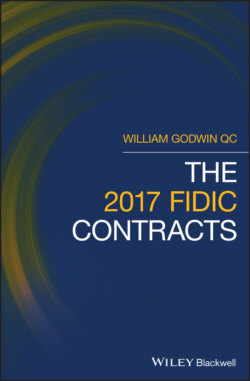Читать книгу The 2017 FIDIC Contracts - William Godwin - Страница 9
1.1 Introduction
ОглавлениеThe second editions of the three main FIDIC construction contracts were formally introduced at the London users' conference in December 2017. The new Red, Yellow and Silver Books had long been anticipated and represented the first update to the three main forms since 1999.
A key aim of the new contracts was to increase clarity and certainty. Users will find several new definitions, which are now in alphabetical order (clause 1.1). ‘Claim’, ‘Dispute’, ‘Notice’ and ‘Programme’, for example, are now defined terms; ‘may’, ‘shall’ and ‘consent’ are also defined, with the particular aim of assisting those whose first language is not English. ‘Particular Conditions’ is now defined to comprise Part A – Contract Data and Part B – Special provisions. ‘Plus reasonable profit’, as used in the 1999 Contracts, often caused difficulty. A new definition, ‘Cost Plus Profit’, now applies, and refers to a percentage for Contractor's profit to be stated in the Contract Data, or in default 5%.
One important procedural change concerns notices in the 2017 contracts. By a new clause 1.3 a notice must be in writing and identify itself as such, among other requirements. Notices are now required in many more situations than previously and, when given, trigger time limits. For example, under a new clause 3.5 in the Yellow and Red Books, or clause 3.4 in the Silver Book, if the Contractor considers that an instruction not stated to be a variation does in fact amount to one he must immediately, and before commencing any related work, give a notice to that effect with reasons. If the Engineer (Red and Yellow Books) or Employer (Silver Book) does not respond to this notice within a defined period by giving another notice confirming, reversing or varying the instruction he will be deemed to have revoked it.
The contract administrator's role in agreeing or determining any claim or other matter under the Contract is also set out in more detail than in the 1999 Books, and in a step‐by‐step fashion with time limits. Clause 3.7 of the 2017 Yellow and Red Books, for example, requires the Engineer first to consult the parties to try to reach agreement; if no agreement is reached within 42 days, or the parties give ‘early notice’ of no agreement, the Engineer must give a notice accordingly and within 42 days (or other agreed time limit) must make a determination. If the Engineer is late then, in the case of a claim, he is deemed to have rejected the claim and for any other matter a dispute is deemed to have arisen which may be referred to the renamed Dispute Avoidance/Adjudication Board (DAAB) for its decision. Similar provisions apply in clause 3.5 of the 2017 Silver Book.
Another key aim in preparing the second editions was to improve project management and reflect international best practice. New procedures designed to promote this aim include requiring the Contractor to prepare and implement a Quality Management System to show compliance with the Contract requirements (clause 4.9.1) and a Compliance Verification System to show that the design, materials, workmanship and certain other matters all comply (clause 4.9.2). There is in general much greater emphasis on dispute avoidance, including an enhanced role for the DAAB in this respect, and promoting cooperation between the parties during the project.
